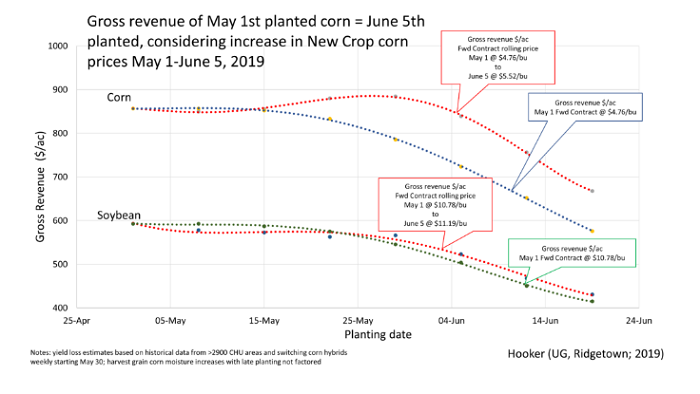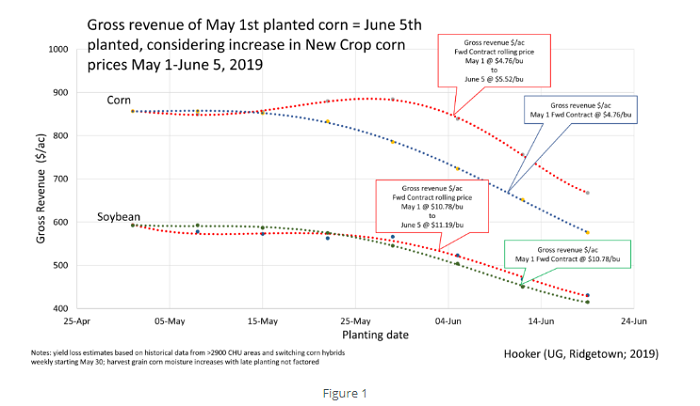
Breakfast Sponsor: Thanks, from the group to Chuck Belanger and Greg Stewart, Maizex
Quote of the week: “Unprecedented” – everybody!
Synopsis: As has been the case this spring, planting progress has been impacted by the frequent rain events and planting in most cases has been concentrated on the lighter textured soils in the area. Growers who can plant have been increasing corn acreage as a result of the conditions. Corn planting around 40% while soybeans under 10% but those numbers will change depending on the rain forecast. Sugarbeet crop is 80% planted while 60-65% of tomatoes are transplanted. Concern with compaction due to the rush to hit planting windows which also brings up an important point – Please remember to be safe whether on the farm and on the road. Temperatures have remained on the cooler side. Wheat is variable and really short which will impact straw. Considerable discussion concerning switching corn hybrid and soybean variety maturities as well as going from corn to soybeans. Refer to Dave Hooker’s comments below (thanks Dave).
Agricorp Report: The average number of winter wheat damage reports as a percent of total winter wheat endorsements for Essex, Chatham-Kent and Lambton Counties is approximately 78%. Chatham-Kent has the most number of damage reports followed by Lambton County followed by Essex County. It is important to note that damage reports do not equate to claims
Planting deadline for processing green peas for Chatham-Kent (excluding Romney and Tilbury-East Townships) has been extended from June 1st to June 11th.
Seed corn planting deadline has been extended from June 15th to June 20th in Area A.
Planting deadline for Black Tobacco in Area A has been extended from June 20th to June 27th.
Please refer to www.Agricorp.com for news and updates to what winter wheat and spring seeded crop insurance covers such as reseeding, USAB (unseeded acreage benefit) and production claims.
Winter Wheat: Wheat acres likely to be below 600,000 this year in Ontario as a result of the winter and spring conditions. The winter wheat crop primarily at flag to heading stage and T3 FHB fungicide applications will start later this week. With the favourable environmental conditions, FHB risk could be high. If a susceptible variety was grown or if the crop was planted after corn or wheat, the risk is even greater and a T3 fungicide application is recommended. Please refer to the DONcast model to assess the risk of your winter wheat field at http://www.weathercentral.ca/ or fieldcropnews.com for more information.
Timing in many stands will be difficult due to the lack of uniformity in fields. While some of the plants, tillers in particular, may be behind the optimal time, applying a fungicide when most of the field is at the correct stage is the best option. Once 75% of the heads on the main stem reach GS59 (head emergence complete) this is known as “day 0”. The optimum fungicide application timing is shortly after this on “day 2” when pollination begins, and anthers are visible on the middle of the wheat head. Two fungicide applications are not recommended as they are generally not economical, particularly in those fields with low yield potential.
REMEMBER TO CLEAN OUT SPRAYER! Tank clean out important especially since everybody in a hurry to get as much done between the rains.
Corn: Corn planting on the lighter soils in the area is basically completed and many growers have increased acres as a result of stronger corn prices. The earliest planted corn is at the 1-2 leaf stage. Dave Hooker wanted to remind the group that soil fitness is more important than soil temperatures. Three of 8 OCC trials planted to date.
As mentioned the frequent rain events – I am being nice here 😊, has many growers switching or contemplating switching to shorter season corn hybrids or to soybeans. The following is from Dr. Dave Hooker, Agronomist with the University of Guelph Ridgetown Campus.
Corn vs Soybean Revenue Considerations at this time of year! Provided by Dr. Dave Hooker.
As of June 4, many growers are considering switching out their corn acres to soybean because of lost corn yield potential and many other factors. However, before making the switch, growers are advised to consider the effect of the current New Crop Corn price on corn revenues. For example, even though grain corn planted on June 5th will lose approximately 15-20 bu/ac in yield potential compared to optimal May planting, using the New Crop Price of $5.52/bu, corn planted June 5th would approximate similar gross revenues compared to corn planted anytime during the month of May with a contracted price of $4.76/bu (see Figure 1 below). Note that the red line for corn in the Figure accounts for fluctuating new crop corn prices and decreasing yield potential, compared to the blue line that shows a reduction in gross revenues at a fixed new crop corn price of $4.76/bu. It is also important to keep in mind that soybean yield potential decreases the same percentage with planting date as corn, until mid-June. Note that yield reductions in the Figure are based on areas with more than 2900 CHU, and that additional drying charges are likely needed for June corn planting.

Soybeans: Some switching to shorter season soybeans with only 10% or the crop planted to date. Reports of millipedes feeding on soybeans.
Forages and Cover Crops: Overall forage quality varies and many continue to mention this is the most alfalfa winter-kill observed and will have a major impact on yield.
Weeds: Weeds have benefitted from the wet and cooler conditions and in many cases growing very quickly therefore it is important to note weed stage and herbicide label timing to maximize control. For many weeds, multiple modes of action required. Good time to remind you that “over reliance” on any one MOA can be problematic. The conditions have resulted in many growers needing to apply a burndown application now or post emerge application so be careful of surrounding crops as well as drift and potential inversion. Also remember to check if the crop emerged as well if there are any crop restrictions when switching from corn to soybeans. Wet and cooler conditions may reduce herbicide breakdown so provide adequate time between application and planting if switching from corn to soybeans. Dr. Sikkema says field horsetail the weed of the year!
Horticulture Crops: Tomato planting to date has 60-65% of the crop in the ground. Normally about 85% of the crop would be planted by now. Tomato transplant quality continues to be good. If rains hold off anticipate total tomato crops by June 12-15. Lots of broadleaf weeds with more herbicide and cold injury then previous years especially on early planted tomatoes. As with all crops, June and July growing conditions will need to be good. The sugarbeet crop is 80% planted and although we started before Michigan growers we are behind them now. Sugarbeet crop stage ranges from 6 leaf to not planted. Michigan sugar was looking for an additional 1000 acres so if interested please contact Michigan sugar.
There are a lot of horticulture crops in the area that can be affected by herbicide drift as well as the plants on rural properties. Be aware of nearby crops, wind direction and speed, and what is in the tank when spraying!
Crop Protection Network (CPN): The Crop Protection Network (CPN) is an excellent resource for the identification and management of corn, small grains and soybean diseases, and general crop management issues. The CPN is a multi-state and Ontario collaboration of 28 US land grant university and OMAFRA Extension specialists. In addition to crop-specific publications, CPN publishes annual crop yield-loss estimates due to diseases, fungicide efficacy guides, feature articles, videos, interactive web-based tools on The CPN website: www.cropprotectionnetwork.org. Ontario’s participation in the CPN has been spearheaded by Albert Tenuta with GFO support.
Source : Field Crop News